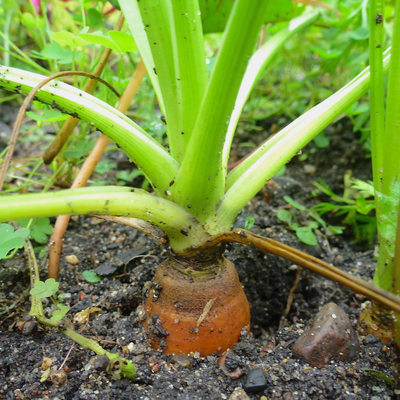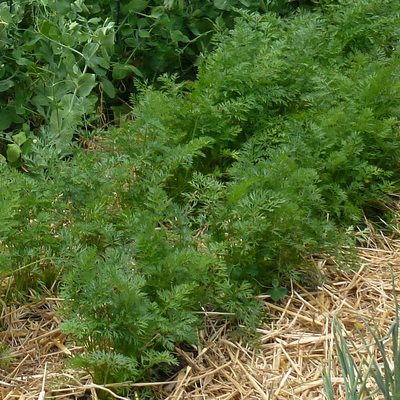A quick guide to carrots and parsnips
- Carrots and parsnips grow best in sandy loam soil.
- Always plant seeds directly into your garden. Never start them in pots.
- The seeds can take up to three weeks to germinate.
- Thin out seedlings to allow room for the roots to develop.
- These vegetables may be bitter, tough, misshapen and undersized if they don't get enough water.
- You can harvest carrots any time they reach a usable size.
- Leave parsnips in the ground until late fall, or even early spring.
Carrots (Daucus carota var. sativa) and parsnips (Pastinaca sativa) are root vegetables that are staples of Minnesota home gardens.
Gardeners choose carrot varieties based on their different characteristics. There are carrots that are best for long storage, carrots with great fresh crunch and carrots that are better for cooking. Some are long and thin. Some are short and squat.
Most parsnip varieties grow quite long, and they taper from a thick top to a narrow end. Shallow, heavy or rocky soils are not good for growing parsnips. If your garden has deep, sandy, loam soil, you should be able to grow a satisfying crop of parsnips.
Soil pH and fertility
- Have your soil tested.
- Carrots thrive when soil pH is neutral to slightly acidic, between 6 and 7.
- Good soil for growing well-shaped roots is a light sandy loam. Heavier clay soils are fine as long as the soil is well-drained and not compacted.
- Grow parsnips in sandy, loamy soils, not heavy clay or silt soils.
- Some carrot varieties will push the tops of the roots up out of the soil. Hilling soil around these plants will keep the roots from turning green.
- Improve your soil by adding well-rotted manure or compost in spring or fall.
- Do not use any fertilizer containing a weed killer ("Weed and Feed"), as it may kill your vegetable plants.
Selecting plants
Carrots and parsnips both grow from small, narrow seed that can be difficult to handle. Some seed houses sell pelleted carrot and parsnip seed, meaning inert material coats the seed. This inert material is usually clay-based, and increases the size of the individual seed. They are easier to plant sparingly and precisely.
Carrot seed is also available as “seed tape,” a paper ribbon containing evenly spaced seeds.
Although the price of pelleted seed or seed tape is higher than the modified seed, many gardeners get better results with less effort when they use these prepared seeds. If you can place the carrot seed evenly every two to four inches using prepared seed, you will save yourself the task of thinning after the plants come up.
If using unmodified seed, try to seed lightly and evenly down the row, although it may be difficult to see the seeds against the soil surface.
Planting
Always direct seed these root crops into your garden. Never start them in pots. Their long taproots begin developing early. Transplanting damages and misdirects their root growth.
In Minnesota, start planting carrots beginning April 15, and parsnips beginning May 1. For a continuous supply of young carrots, make two or three plantings spaced three weeks apart. The seeds may take as long as three weeks to germinate.
- Newly emerged carrot and parsnip plants are very small, with two thin grass-like leaves. The next leaves to emerge will appear frilly or fern-like.
- Carrot roots can reach their full length within three weeks of seedling emergence.
- The tiny plants may have trouble emerging if there is a crusted soil surface, as may happen after a heavy rain or excess watering. Moistening the surface of the soil with a light spray of water may make it easier for the seedlings to come up.
- Some gardeners plant radishes in the same row as their carrots or parsnips. The radish seeds germinate quickly and their distinctive leaves mark the row. You can pull and eat the radishes as the carrots emerge from the soil, giving the carrots more room.
- You must thin out both carrots and parsnips to allow room for the roots to develop properly.
Spacing between carrot plants - When the largest seedlings are three to four inches tall, thin by pulling up extra seedlings so that the remaining plants are about two to four inches apart.
- While thinning, be sure to eliminate any weed seedlings as well.
- Leave wider spacing for varieties that will be larger at maturity.
How to keep your carrots and parsnips healthy and productive
- For best quality and size, both carrots and parsnips require good soil moisture.
- If they do not receive an inch of rain each week, use irrigation.
- Roots may be bitter, tough, fibrous, misshapen and undersized it they don't get enough water.
- Water deeply once a week on heavier soils, twice a week on sandier soils. An inch of water will wet a heavy clay soil to six inches, and sandy soil to a depth of ten inches.
- Use a trowel to see how far down the soil is wet. If it is only an inch or two, keep the water running.
- Frequent, shallow cultivation with a hoe will kill weeds before they become a problem.
- Cultivate just deeply enough to cut the weeds off below the surface of the soil. Be careful not to damage the plants when cultivating.
- Mulching with herbicide-free grass clippings, weed-free straw, or other organic material to a depth of three to four inches can help prevent weed growth, decreasing the need for frequent cultivation.
Carrots
You can harvest carrots anytime they reach a usable size.
Irrigate the day before harvest or dig them after rain, to ensure root hydration.
Push a garden fork into the soil near the plant, pushing the root to the side to loosen the soil, and pull it out of the ground. Simply pulling without freeing the carrot from the soil first can result in a broken root.
- Remove the greens and clean the roots before consumption or storage.
- Store harvested carrots in the refrigerator for immediate use.
- Modern refrigerators have relatively low humidity, so the carrots will lose moisture. The normal temperature of a home refrigerator is usually above 32°F. Carrots held above freezing will begin to sprout.
- For longer-term storage, a root cellar can be ideal, though few gardeners have one.
- You must process canned carrots using a pressure canner.
- You may also pickle, process in a boiling water bath, blanch, or freeze carrots.
Parsnips
- Leave parsnips in the ground until late fall or even early spring.
- Cold soil temperatures influence the flavor of the roots, increasing the sugar content. The later you dig out the roots, the sweeter they will be.
- As the soil warms up later in spring, the plant will start to send up a flower stalk. The parsnip will taste worse at this point.
- Parsnips can be 10 to 12 inches long, so be careful not to break them when harvesting. It is best to dig them up with a spading fork.
- For fall-dug roots, a root cellar is the best storage option.
Managing pests, diseases, and disorders
Many things can affect carrot and parsnip roots and leaves. Changes in physical appearance and plant health can be caused by the environment, plant diseases, insects and wildlife. In order to address what you’re seeing, it is important to make a correct diagnosis.
You can find additional help identifying common pest problems by using the online diagnostic tools or by sending a sample to the UMN Plant Disease Diagnostic Clinic. You can use Ask a Master Gardener to share pictures and get input.
- Cutworms can cut young plants off at the base.
- Root maggots feed on and destroy the roots of many crops.
Aster yellows is a disease of many garden plants spread by leafhoppers, small insects that feed on plant juices. Symptoms are hairy, bitter roots and yellow tops.
- Forked, or split, roots may result from rocky, heavy, or compacted soil. A drought can also cause split roots.
- If the plants develop healthy green tops, but limited root growth, it is usually because the plants are crowded.
- Excessive nitrogen fertilization can also contribute to lots of leaf growth at the expense of root growth.
- Skin sensitivity to parsnip leaves can be a problem. Some people develop a rash from contact with parsnip leaves, particularly on bright sunny days. Wear long pants, long sleeves and gloves when weeding or harvesting parsnips.
Reviewed in 2022





